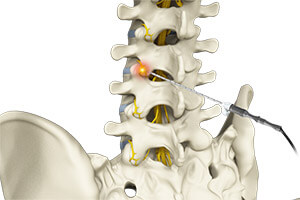RADIOFREQUENCY ABLATION TREATMENT
 Radiofrequency ablation, commonly referred to as RFA, is an effective long-term treatment for mechanical neck and low back pain due to joint inflammation. The goal of radiofrequency ablation is to provide long term relief of joint mediated pain than regular steroid injections can provide. The treatment is indicated once the joints have been precisely identified as a primary pain generator and steroid injections are only effective for short periods of time. In the spine, radiofrequency ablation is used for facet joint and sacroiliac joint pain.
Radiofrequency ablation, commonly referred to as RFA, is an effective long-term treatment for mechanical neck and low back pain due to joint inflammation. The goal of radiofrequency ablation is to provide long term relief of joint mediated pain than regular steroid injections can provide. The treatment is indicated once the joints have been precisely identified as a primary pain generator and steroid injections are only effective for short periods of time. In the spine, radiofrequency ablation is used for facet joint and sacroiliac joint pain.
The radiofrequency ablation procedure is an outpatient procedure which traditionally takes about 30 minutes to complete. There is additional time required for observation after intravenous sedation.
ANATOMY
Facet Joints
There are two small facet joints in the posterior column of each vertebral segment that provide the spine with both stability and flexibility. Facet syndrome occurs when one or more of these joints become inflamed or irritated. Patients often report increased back pain with extension or prolonged periods of inactivity like sitting or standing too long. Changing positions often improves the pain.
Sacroiliac (SI) Joints
The sacroiliac joint is a mobile strong weight bearing joint in the pelvis that connects the sacrum and pelvis. There are two joints, one on each side of the sacrum, reinforced by strong surrounding ligaments. Pain can be from inflammation of the sacroiliac joint, called sacroiliitis.
This is commonly felt as pain on one side of the lower back to the right or left of midline where the joint is located. When SI joint dysfunction is severe, pain can refer to the hip, groin, buttocks, and even down the back of the thigh. Pain may be worse with movements that stress that joint, such as standing up from a seated position, walking up an incline, elliptical exercise, prolonged sitting or walking, or twisting when rolling in bed at night.
PRODECURE
A radiofrequency procedure interrupts the sensory nerve supply to the involved joint through the use of thermal denervation. Under local anesthesia with light intravenous sedation, our Pain Management Specialists at Harley Street Orthopedics & Sports Medicine will use fluoroscopic (x-ray) guidance to place special radiofrequency needles in the proximity of the nerves that supply the inflamed joint. After testing to ensure that the needle is in the correct position, a heat lesion is generated to deaden the nerve.
The radiofrequency ablation procedure is an outpatient procedure which traditionally takes about 30 minutes to complete. There is additional time required for observation after intravenous sedation. Symptom relief can range from six months to a year but can last longer as well. It can be repeated in six months to a year, if needed. Radiofrequency has been performed safely for many years with excellent outcomes. You may have a sore back or neck for one to two days immediately afterwards. It is recommended that you take it easy on the day of procedure, but return to usual activities the following day. The benefit from this procedure will typically occur within two weeks.














